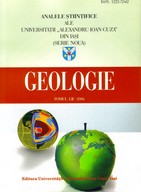
English title
- SERIA
GEOLOGIE (AUI-G) - |

|
| Log in New account |
| Home | Main Page | Guide for Authors | Peer Review | New Articles | Events | Archive | Index | Contact us |

|
Article PRECURSOR ROCK AND ORIGIN OF CORDIERITIC XENOLITHS FROM THE VECHEC ANDESITE QUARRY, EASTERN SLOVAKIA
MARIÁN KOŠUTH - Technical University of Košice, Institute of Geosciences, Faculty of Mining, Ecology, Process Control and Geotechnologies, 15, Park Komenskeho, 04384 Košice, Slovak Republic ZDENKA MARCINČÁKOVÁ - Technical University of Košice, Institute of Geosciences, Faculty of Mining, Ecology, Process Control and Geotechnologies, 15, Park Komenskeho, 04384 Košice, Slovak Republic View abstract as pdf file | View full article as pdf file Abstract: The composition of dark coloured enclosures from andesitic rocks, found in the Vechec
quarry, was investigated, using the combination of microscopic, XRD and EPMA methods.
The xenoliths are formed mainly of cordierite (XFe = 0.23-0.47), associated with plagioclase,
Fe-spinel (up to hercynite) and minor anorthoclase, biotite and ilmenite. The Na2O and K2O
amounts (up to 1.28%), the plagioclase of Ab82.5–74.99 composition and the very low contents
of Ni and Cr even in Fe-spinels emphasize an alkalis contamination of the precursor magma;
therefore, the precursor rock is assumed to be derived from an upper crustal material. Among
the numerous basement xenoliths, including argillaceous ones, the dark-gray, slightly
laminated xenolith is the only highly aluminous one, with contents close to that of the
cordieritic type. The plagioclase-rich protoliths, with common purple spinel octahedrons and
Ti-minerals, show some magma imprint. The cordierite-rich rock is assumed to be formed
from the dark Al-Fe-Mg(Ti)-rich melt, in the inner aureole of the magma chamber. Keywords: andesite, xenoliths, precursor rock, X-ray diffraction, phase composition |
copyright © 2024 Department of Geology |